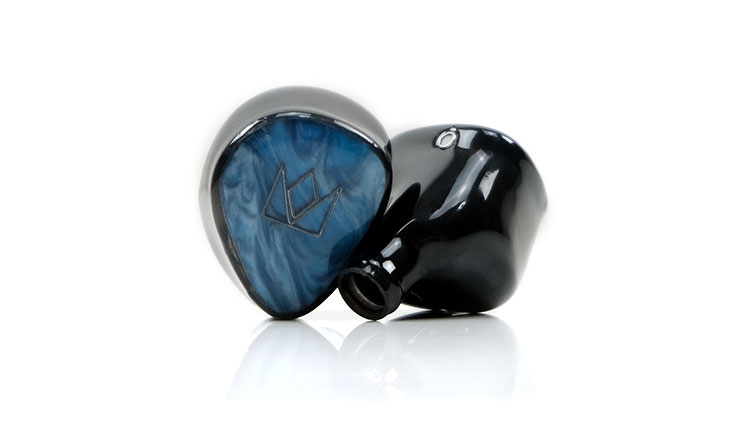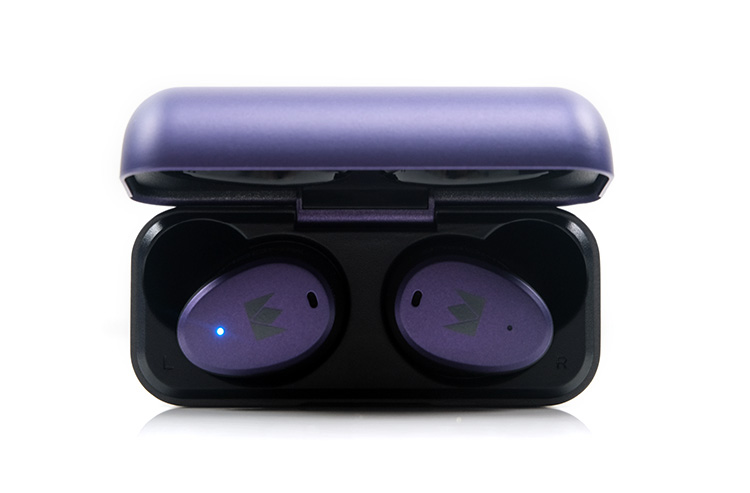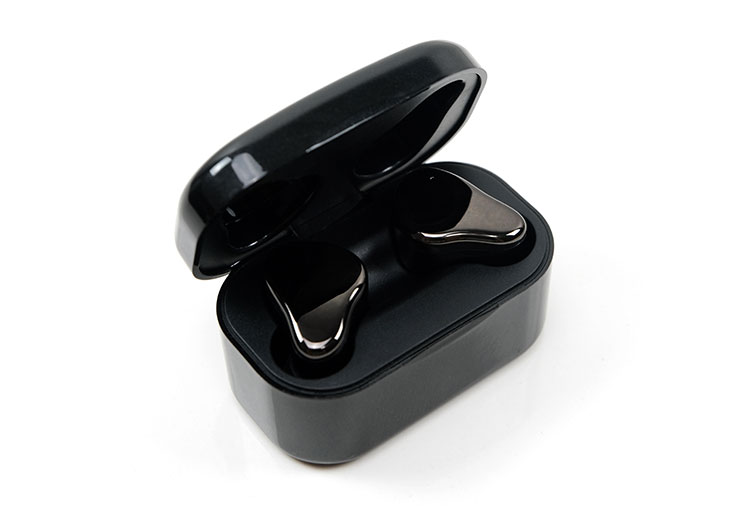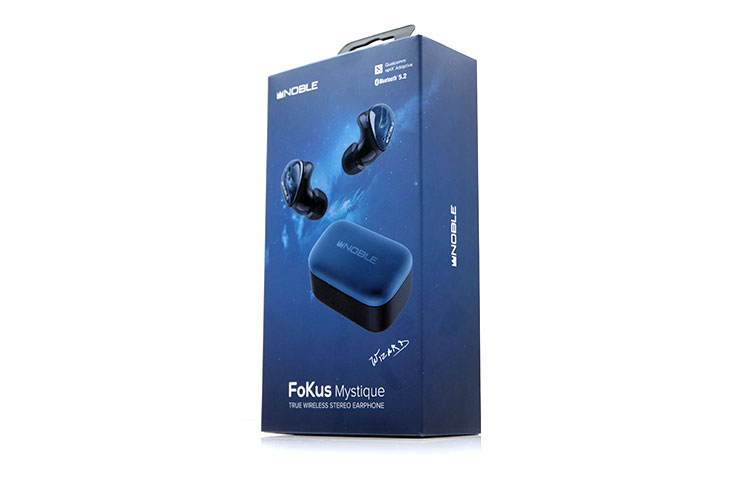Select Comparisons
All comparisons below were completed using the stock tips of each TWS combined with an Apple iPhone 13 Mini, Samsung Z Flip 3, and a Huawei Mate Xs 2 as Bluetooth transmitting sources.
Noble Audio FoKus Pro
$349
Now discontinued in favor of the FoKus Mystique, the FoKus Pro was launched in 2021 and was our Top Gear TWS Award winner for the same year. You can read our full review of the FoKus Pro here.
Technical
There is quite a lot of commonality here, at least on paper. Both the FoKus Mystique and the Pro use a multi-driver hybrid design with a single customized 8.2mm dynamic for the lows/mids and a pair of customized Knowles dual BA for the mid-highs and highs.
They also share a Qualcomm QCC3040 Bluetooth SoC capable of up to BT5.2 and can decode from SBC/AAC up to aptX Adaptive though neither offers any LDAC capability.
The battery life is similar at 7.5 hours per bud with a 500mAh cradle that is capable of up to 4 additional charges or a max of 30 hours with USB-C but no wireless charging.
Software integration is a mirror for each with both the FoKus Mystique and the Pro nestled inside the wider FoKus branded app for both iOS and Android. They offer the same level of controls and access to EQ presents including customization.
The one key difference though is the microphone setup on the FoKus Mystique which is now shifted to the faceplate and includes the new Ambient mode for call clarity and situational awareness, something that the Pro version does not offer. It is also controllable via the FoKus app.
Design
They look similar but in actual fact, there are a fair few changes from the Pro version to the FoKus Mystique.
Aesthetically the FoKus Mystique has a new set of dark starry nebula plates with an updated Noble branding design at the plate edges. It also has a slightly larger form factor with more aggressive contouring on the black resin shell.
The FoKus Mystique venting port has also moved from the side of the driver shell to the front which breaks the design flow of the plates just a little but nothing too noticeable. On a technical level, those mics have also moved to the plate though that is not something you will see.
The Mystique cradle has also undergone some superficial changes. It is still a black and black combo but the finishing on the lid feels slightly grippier and more textured than the Pro version.
The little lid wedge on the underside of the Pro version is now gone also and I presume that is due to the larger driver shell dimension not requiring support to stay in place.
Both TWS have fairly long nozzle penetration capability but the wider shell base of the FoKus Mystique gives it a more secure fit. Neither are ANC-quipped so tips and insertion depth play an important role in passive isolation performance. To that end, the Mystique is slightly superior with both of the supplied stock tips.
Performance
Same driver configuration but oh boy what a contrast in performance and tuning between these two. The FoKus Mystique is probably the more grandiose sounding of the two with a v-shaped bias sound signature whereas the Pro version is more intimate, more mid-forward, and more aggressive sounding at the same time.
The Mystique pulls back on the mid-forwardness and instead emphasizes the low-end and treble a little more but it is tastefully done with a nice balance in terms of tonal contrast. This is not a hollowed-out curve lacking in any mids presence.
The FoKus Mystique also has a lower-mid lift solidified by a stronger bass fundamental as well as some additional warmth coming up from the mid-bass. You could also argue it is a little lighter in weight for vocal texture compared to the meatier Pro’s vocal performance but it does benefit from space and improved headroom.
The Pro is tighter and punchier sounding but lacks a little comparative meat on the bone sub-80Hz. It seems to extend almost as well as the FoKus Mystique but just not the same level of note body and presence so you get a more emphasized mid-bass slap coming through.
Given the differing FR emphasis, the FoKus Mystique’s soundstage creates a stronger perception of space and the Pro’s more intimate delivery does better with more mids-focused acoustical arrangements.
I would take the Mystique quicker for ambient recordings, music with scale, or emphasized lows and highs. I would pick the Pro instead if I wanted to hone in on the vocal delivery or high-energy punchy-sounding musical genres.
Noble Audio FoKus H-ANC
$199
The FoKus H-ANC was launched in the middle of last year and we have it down for review very shortly. It is positioned slightly below the FoKus Mystique but is the only TWS product from Noble to offer ANC.
Technical
The H-ANC is a step down so whilst also a hybrid driver setup, it’s a little simpler with a single titanium membrane dynamic driver for the lows and mids and a RAN Knowles BA for the highs. One thing to note is the size of that H-ANC driver at 10mm which is a bit bigger than the 8.2mm version inside the FoKus Mystique.
Both TWS offer BT.52 capability though the H-ANC uses a cheaper Airoha 1562A chip as opposed to the Mystique’s Qualcomm SoC and decoding is also less capable with just SBC/AAC as opposed to AptX Adaptive.
Of course, the elephant in the room is the H-ANC’s ANC capability which the FoKus Mystique does not have. Both have good microphone setups but with only Ambient mode capability, the Mystique will rely more on the fit and tip selection for isolation performance.
If you think having ANC will dim the battery life of the H-ANC think again. With ANC you get a very healthy 8.5 hours which is a bit higher than the FoKus Mystique and without it’s an outstanding 12 hours. The cradles of both are around 30 hours in total with similar USB-C and no wireless charging capability.
Both TWS fit into the Noble FoKus app with similar features save for the ANC option on the H-ANC version. You can still choose the same EQ presets or use your own custom version.
Design
The H-ANC definitely feels and looks a bit cheaper than the FoKus Mystique though given the lower price tag that should not be a surprise.
Instead of metals for the cradle you get plastics and a little bit of creak in the hinges along with it. The overall aesthetic is more of a crossover from the Falcon Pro and the old unibody designs of Noble’s classic wired IEM lineup.
It is not quite as aggressively contoured as the FoKus Mystique resin 3D printed shell nor as elaborate on the front plate design either. It is tidy looking however and has more of a comfort-friendly fit than most with the signature Noble deep nozzle fit.
To be honest, on a passive level, the performance of both is almost exactly the same. And being the same here means really good with a secure fit along with it. If I had to make a call between them I might just give the FoKus Mystique a slight edge but this is very much dependent on your own personal fitting experience.
However, with ANC turned on the H-ANC becomes the superior choice growing out a lot of low-frequency background noise which the FoKus Mystique is less likely to do. I suspect that will be the case with everyone’s experience when comparing both of them side by side.
Performance
The ability for the FoKus Mystique to decode at aptX Adaptive combined with the additional driver makes the difference in terms of technical capability. The H-ANC just lacks the clarity and dynamic range of its bigger sibling sounding somewhat softer and less engaging using SBC or AAC codecs.
The FoKus Mystique has a superior extension at both ends of the frequency curve with improved headroom and a tighter more defined bass delivery. It creates a better sense of space through the mids with a more vivid and detailed vocal performance and more fizz and energy in its percussion timbre.
One could argue that the H-ANC is the more forgiving of the two TWS sound signatures but for me, it can come across as a bit blunted in treble overtones and a little too even-harmonic dominant.
Yes, it’s smooth sounding with a punchy meaty fundamental from that 10mm driver that works really well with modern rock and pop, but it lacks the sparkle and air to give the mids some presence and variety in their delivery.
The Mystique, though by no means a neutral-colored TWS, still sounds the more tonally accurate and life-like performer. That additional headroom combined with the improved bass layering and acoustical imaging sounds gives it a more complete and satisfying staging quality.
Overall, the H-ANC is where it should be in terms of product positioning and that is below the FoKus Mystique. ANC is a huge plus but performance wise the Mystique brings a lot more to the table.
GeekFly GF8s
$219
The Geekfly GF8s was launched in 2021 and still stands as one of the most complex TWS designs in the market today. You can read our full review of the GF8s here.
Technical
The GF8s is probably the only TWS that I know of that is even more complex than the FoKus Mystique in terms of driver implementation.
This is a mix of 3 different drivers with a single titanium-plated 7mm dynamic driver for the lows and mids, a single balanced full-range armature for the mids and mid-highs, and a 10-layer piezoelectric ceramic tweeter for the super-highs.
The FoKus Mystique uses a slightly larger 8.2mm driver for the lows but keeps the timbre consistent for mid-highs and highs using a dual BA design.
One thing to note is the additional use of a Class A amplifier driver inside the GF8s rather than the BT receiver SoC built-in amplifier. It will suck a lot more juice but it is to be commended for a TWS design to even go near an amplifier design such as this.
In most other areas, however, the FoKus Mystique is more capable. That included BT5.2 capability as opposed to the GF8s on an older BT5.0 and also a stronger decoding capability at a maximum of aptX Adaptive as opposed to just SBC inside the GF8s.
The Geekfly also has no integrated software app or ambient mode though, like the FoKus Mystique it does have touch controls. With a Class A amp, the GF8s battery life is unsurprisingly poor at just 5 hours per shell and its small cradle offers an additional 20 hours. The Mystique can do better at 7.5 hours with an additional 30 hours in the cradle.
Design
The GF8s is a bit of a plain Jane. I mean it’s smoothly finished, shimmery in part but the plasticky materials and form factor are more generic compared to the FoKus Mystique’s more aggressive and intricate IEM-like design.
That being said, the comfort levels when using the GF8s are quite good with a passive isolation level not too far off the FoKus Mystique. neither are ANC-equipped so both comfort and tip performance are critical.
The supplied GF8s stock tips are not as varied but I found the single flange silicone tips to give me a secure fitting experience. The Mystique does better here with more choices. The single flange is more comfortable but the sealing pressure is slightly better on the dual flange alternatives.
Touch control lag is slightly longer with the GF8s compared to the FoKus Mystique though by no means sluggish. Rather the Mystique is simply quite tight and more intuitive given you can customize it via the integrated app at the same time to suit your needs.
A final word on the cradle which follows the same theme as the drivers using a slightly cheaper all-plastic black design for the Geekfly cradle compared to the sturdier blue/black metal and plastic mix of the FoKus Mystique version.
I give props to the GF8s cradle for being smaller and lighter with less hinge creek compared to the H-ANC but it’s not as durable or as premium looking as the Fokus Mystique cradle.
aptX Performance
I actually switched over to an iPhone 13 Mini using its AAC output just to get a better sense of the performance of these two with similar codecs and compression rates feeding through them.
With aptX-capable Android phones there is really no contest in terms of dynamic range and clarity with the FoKus Mystique the clear winner in both categories.
Of course, I give props to the excellent low-end driver inside the GF8s. With its above-average texture and sub-bass presence it can out-rumble the Mystique equivalent at times.
But with an aptX capable Android smartphone such as the Samsung Z Flip 3, it sounds a little on the slow side and lacks the same energy and layering capability as the Mystique’s equivalent low-end performance.
That heightened SBC/AAC compression holds back the GF8s’s performance making it sound a little dull compared to the aptX Adaptive capable FoKus Mystique.
AAC Performance
With AAC out of an iPhone 13, the gap is closed though not in a good way. Both now sound fairly compressed and lacking in dynamic range, though at least now you can pick out where the tuning markedly differs.
The Mystique is cleaner sounding, perhaps a little cooler, and more accurate in the timbre also. The biggest difference is the treble overtone from the FoKus Mystique and there is a lot more there, both in terms of presence and extension.
The GF8s is much more relaxed in its treble tuning and a bit warmer overall which might surprise some given it uses a piezoelectric tweeter. You only get a sense of it when you hear a high-pitched note, like a little rapid clean zing effect rather than a physical thud.
Vocal presence is also more prominent on the FoKus Mystique compared to the GF8s, especially male rock vocals. Again, a lack of treble contrast and a lack of air produces a slightly duller rounded tone on the GF8s.
The Mystique lower register male vocal imaging is not hugely forward either but a cleaner tone and a better sense of space combined with a snappier shorter level of note decay help to give it some improved clarity.
Our Verdict
The Noble Audio FoKus Mystique is an evolutionary technical step forward from the previous FoKus Pro but also quite a different performer sound-wise.
It has added some new features such as Ambient mode and refined the external design into something even more like a true IEM experience. Most importantly, it’s still one of the most complete TWS sound signatures in terms of resolving capability and a pleasing tonal presentation.
For previous Pro users, I would suggest you demo before chucking the old one away. Different is not necessarily better unless the previous tuning was not to your tastes in the first place. There is a bit more weight and shine on the new sound but a little less mids-forwardness also.
I do admit I would love to hear an LDAC ANC-equipped version sometime in the future. Would that not be the perfect generation 3 of this TWS or any TWS for that matter? For now, though, it’s the one to beat for me, at least performance-wise.
Noble Audio FoKus Mystique Specifications
- Drivers: 2 x Knowles Balance Armature drivers, 1 x 8.2mm dynamic driver
- Bluetooth: 5.2 supports SBC, AAC, aptX, aptX Adaptive
- SoC: Qualcomm SoC QCC3040 chipset
- Battery: 7.5 hours at 50% volume
- Battery Case: 500mah battery delivering 4 extra charges
- Dedicated Noble FoKus app for personalized tuning and 10-band EQ with presets









